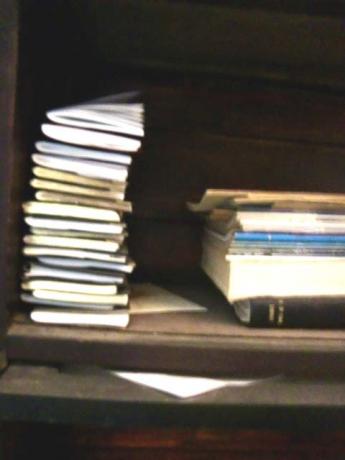Website Antiquarian Booksellers' Association of America Ten Pound Island Book Company
Collecting Rare Books and First Editions: Time Travel for Dummies

By Greg Gibson
When my accountant said, “Hey, you’ve had another good year,” my response was, “You’ve got to be kidding!” But then, looking back, I remembered some happy referrals, several fascinating consignments and, in general, quite a bit of successful book scouting. Ten Pound Island’s invoices and check stubs (all digital!) told the story in detail. My "new business model," concocted so painfully over the past year, paid off. I dropped the California, Florida, and New York book fairs, cut expenses way back, moved from hard copy to web based catalogs, and quoted a lot more books using specially tailored, richly illustrated e-based catalogs.
About 400 transactions pushed income to a new high.
And what did I do with my riches? Signed up for the California, Florida, and New York book fairs, and went back to printed catalogs. As a result, my costs of goods and business expenses were a scary percentage of my income. Still, on paper at least, there was a surplus. I was left wondering, as I wonder every year, “Where did it all go?”
Well, among other things it went to paying down debt, to inventory, and to development costs for My Big Hole (the new gallery across the Street) as well as toward funding my several writing projects, which consumed hundreds of hours and thousands of dollars in expenses – while grossing a cool $3750 for 2010.
A more perplexing question was, “Where did the time go?” It seems like just a few weeks ago I was sitting at this very desk, in front of this same computer, same coffee, same cup, writing my blog entry summarizing the year gone by. Now here I am again.
The feeling is less “Groundhog Day” than a kind of time travel, a state in which the only thing separating January 2, 2012 and January 2, 2011 is the thinnest membrane of a miraculous, selectively permeable fabric. Memories get through; sensations, thoughts, and feelings pass from then to now effortlessly. But my knees aren’t coming back, nor is that whaling log I should have bid on more boldly.
Another property of this strange boundary is the condensation of time. I reach through the membrane to grab a memory from last year, and find my hand full of 1990 or 1970. I watch my granddaughter dancing in the living room and I see my own daughter dancing in the same spot twenty-five years before. For the past few years I’ve been saving my date books. But it isn’t “the past few years.” Suddenly it’s a mighty tall stack.
All this puts me in mind of an excellent novel by colleague Stuart Bennett. It’s called A Perfect Visit and the “visit” involves excursions back through time to the eras of Jane Austen and William Shakespeare. There’s adventure, romance, and just enough bookish content to keep a smile on my face. Come to think of it, isn’t that kind of time travel every book dealer’s dream? Imagine walking into a printer’s workshop and picking up a First Folio! I don’t need to worry about spoiling the ending for you because I haven’t gotten there myself.
But that’s just a matter of time.
Meanwhile, back in the shop, the present churns away – a phenomenon for which I am, and will continue to be, most grateful. And grateful, too, for the cool things that come my way.
LE NAVIRE AMERICAIN LE SUSSEX CAPT. POLLARD ATTAQUE PAR UNE BALEINE MONSTRUEUSE... 1820.
The whaleship Essex left Nantucket in 1819. On November 20, 1820, while cruising the offshore ground, the ship was rammed sunk by a large sperm whale. Twenty-one survivors set off in three whale boats for the coast of South America, 2000 miles to the east. The mate, Owen Chase, published an account of the harrowing sail which featured agonizing deaths, madness and cannibalism. His book, which Melville recieved from Chase’s nephew during his whaling career, accounted for the key plot point in Moby Dick. The incident became one of the best known sea stories, inspiring the likes of Philbrick’s “In the Heart of the Sea.” This is a rare early French lithograph, probably contemporary with news of the incident.
Charmingly, in the excitement of the moment, it has the name of the ship wrong - “Sussex” instead of “Essex” - and shows a baleen whale rather than a sperm whale ramming the ship. Rare. Not in Brewington. No holding on Worldcat. Image size 12 1/4 x 16 1/2. There are a few spots of light abrasion on the right end of the caption, partially obscuring the name of the lithographer. Otherwise this print is in very good condition, with rich, strong tones and generous original margins. $4000
The article is published in Bookman’s Log, it is presented here by permission of the author.


